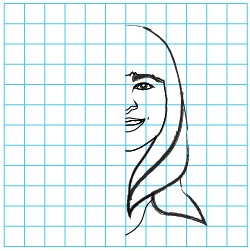Lesson 2: Reflections
Focus

Comstock/Thinkstock
A portrait is an interesting way to celebrate people in your life. A strong portrait captivates viewers, causing them to wonder about the person depicted, almost like a visual biography. Proportions of a head will vary from person to person and change slightly with age, but there are some basic principles in creating portraits.
Look at the following diagram of half a face. Suppose you wanted to complete this picture. Could you do it? How would you decide where the other eye should go? Where would you start to draw an ear? Would your strategy work for any half picture?

Lesson Outcomes
At the end of this lesson you will be able to
- determine the relationship between the coordinates of a point and the coordinates of that point reflected across the x-axis or y-axis
- sketch the graph of the functions y = f(−x) and y = −f(x) given the graph of y = f(x)
- determine the equation of a function given its graph, which is a reflection of the graph of y = f(x) through the x-axis or the y-axis
Lesson Questions
You will investigate the following questions:
- How is a point related to its reflection?
- How are the graphs of the functions y = f(x), y = f(−x), and y = −f(x) related?
- How can you graph the function y = f(−x) or y = −f(x) given y = f(x)?
Assessment
Your assessment may be based on a combination of the following tasks:
- completion of the Lesson 2 Assignment (Download the Lesson 2 Assignment and save it in your course folder now.)
- course folder submissions from Try This and Share activities
- additions to Glossary Terms and Formula Sheet
Materials and Equipment
- graph paper